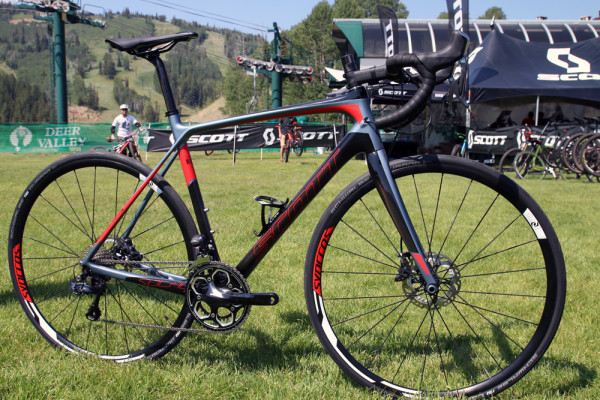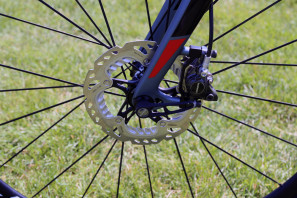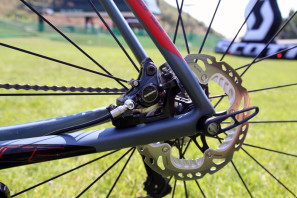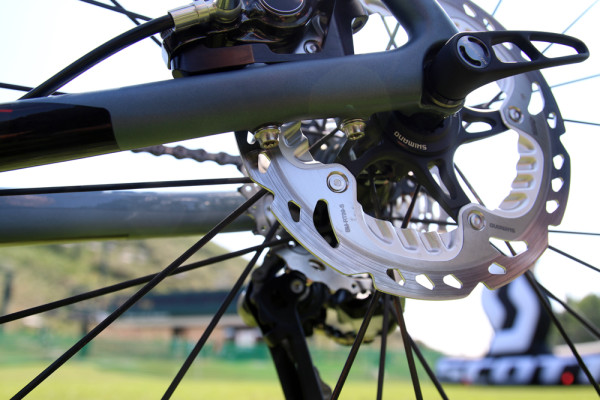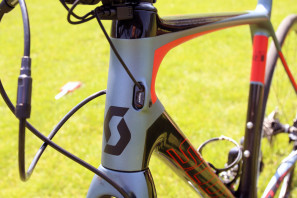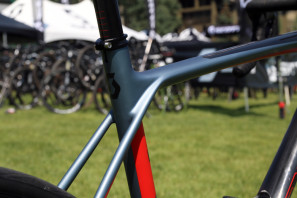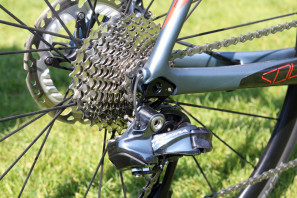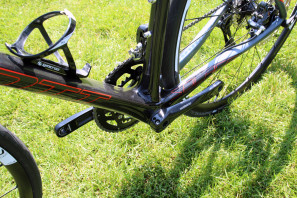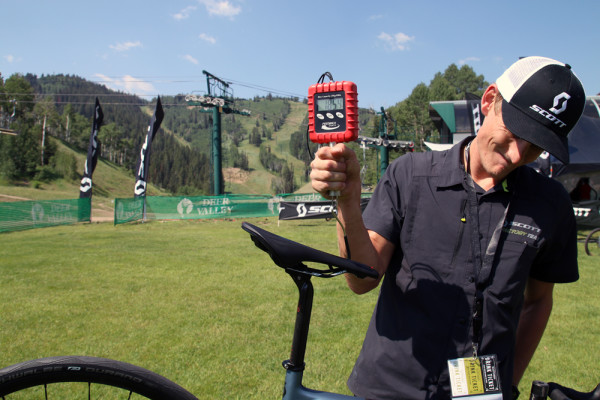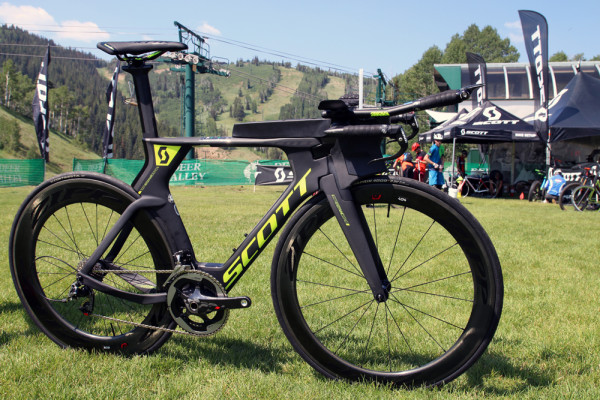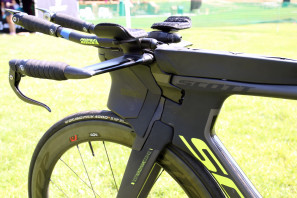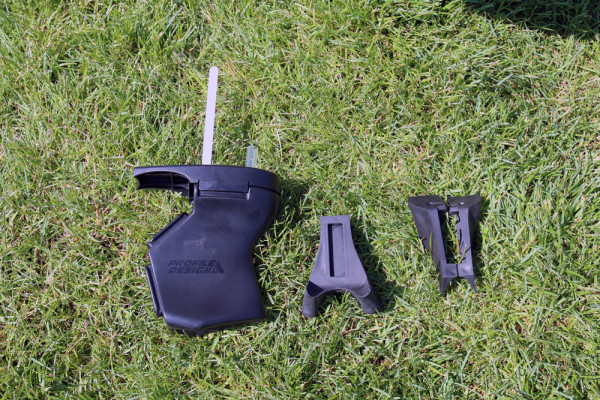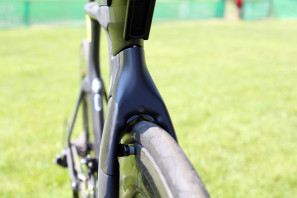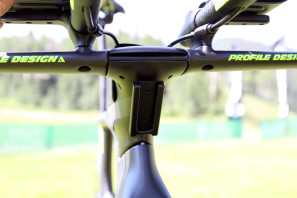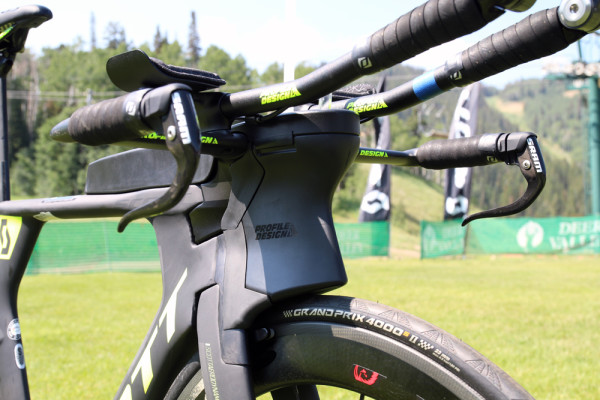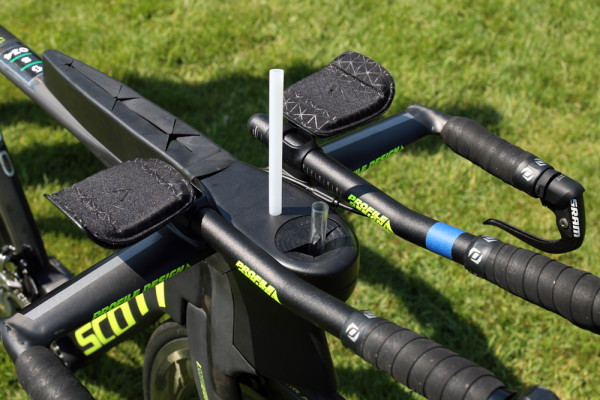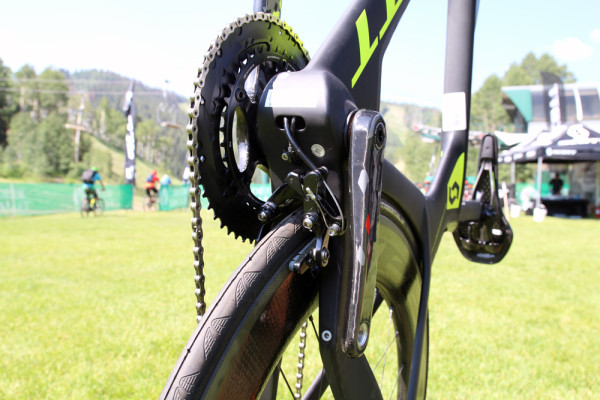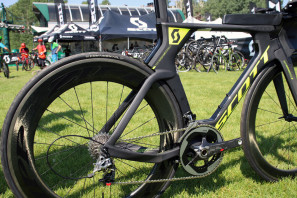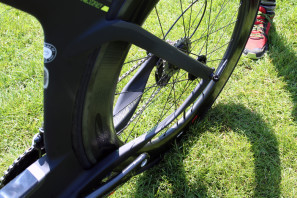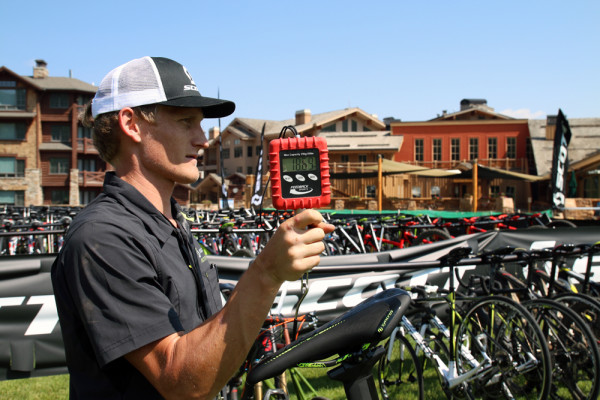At this point, we’re all pretty aware that disc brakes for road bikes are here to stay. Lately the conversation seems to focus on how manufacturers will address the issue of axle standards, and now even the brake mounts themselves are in question. For their foray into the world of disc brakes, Scott has adapted their Solace endurance frame which was initially launched last year in rim brake versions only. In 2015 the Solace will still be mostly rim brake equipped, with the Solace 15 Disc the solitary model running discs.
Perhaps more important than the brakes is the fact that Scott has chosen to equip the Solace 15 with thru axles front and rear. Oh, and the rear brake mount is pretty interesting as well…
More on the Solace 15, plus an up close look at the new Plasma 5 rocket ship, next!
Judging by the comment section on any of our articles regarding road discs, there seems to be mixed opinion surrounding thru axles on road bikes – especially 142×12 rear spacing, which is found on the Solace 15. According to Scott’s engineers, the addition of a 15mm thru axle for the front wheel means they can offer the same compliance out of the fork with less weight than a quick release. In order for the QR disc fork to be as stiff as the TA disc fork with the same compliance, it would require 8% more carbon reinforcement. So while the QR itself may be slightly lighter than the TA, the combination of fork and thru axle ends up being lighter in the end. The use of a thru axle also guarantees exact brake rotor placement with wheel changes.
The Solace 15 uses Syncros RWS thru axles that function just like the DT-Swiss RWS axles, simply threading tight in a clockwise direction. To remove, just unthread counter clockwise until the threads disengage and remove the axle.
Apparently, there is just as much confusion surrounding Shimano’s new Flat Mount standard for OEMs as there is for consumers. To us, the brake mount on the rear of the Solace certainly looks like other Flat Mount drawings we’ve seen. However, we weren’t able to get the answer to whether or not this is the new mount from the Scott engineers at Scott Week. What is known is that instead of post mounts the Solace uses bolts that thread up from the bottom, through the chainstay into a specially designed brake adapter.
Obviously there has been a lot of groaning due to a new “standard,” but we’re interested to see what Shimano has up their sleeve for the new mount. It seems the only reason to create a new mount would be to allow for designs that aren’t currently possible with a standard post mount. Does that mean we’ll see “aero” disc brakes or even smaller rotors in the future? Time will tell, but for now just know that like the Solace above the new mounts will still work on current brakes and may mean easier adjustment.
As a frame, the Solace 15 Disc offers the same comfort story as the rim brake models with comfort geometry that includes a 1cm shorter TT, and 1cm taller HT than their race geometry. Using a specific carbon layup for each size combined with 2 different fork layups, each bike is built to ride appropriately for the approximate rider weight of each frame size. Split into two “zones,” the Solace frame is 42% more comfortable than CR1 in the Comfort Zone (seat tube junction and fork blades), while offering a Power Zone that is 17% more stiff than the CR1 throughout the downtube, bottom bracket and chainstay.
Other frame details include a BB86 pressfit bottom bracket, tapered 1.125-1.25″ head tube, an integrated chain catcher, and internal cable routing with a chip for mechanical or electronic drivetrains. In order to get the Solace 15 Disc built for the show, Shimano hydraulic brakes with an Ultegra Di2 drivetrain were used, but production bikes will be Ultegra mechanical for the drivetrain with hydraulic brakes. Due to the 142×12 rear axle, the frame takes advantage of the IDS derailleur hanger that the axle threads into for improved shifting performance.
As for the weight? This bike was not built with the production spec, but gives us a rough idea of what to expect from a 56cm at 18.54 lbs. Production models will be equipped with Shimano Ultegra mechanical and hydraulic brakes instead of the Ultegra Di2 shown here. This bike also has a bottle cage, which adds something like 40g to the weight. Claimed weight for the actual spec is 16.45 lbs, with the frame measuring 990g and 390 for the fork.
When it comes to triathlons and time trials, Scott Sports has a new weapon in the all new Plasma 5. In its first month, the bike has already helped Sebastian Kienle not only win the Ironman European Championship, but smash the bike leg record by 8 minutes. Boasting a frame that is 7% more aerodynamic, 47% stiffer, and 130g lighter, the Plasma also moves to integrate rider fuel storage to create a modern super bike.
To conform to UCI standards, the 5 is offered in two configurations – Triathlon with the storage box and nose mounted aero bottle, and TT which forgoes both items. According to Scott the bike is 7% faster than the Plasma 3 with the aero bottle installed, but still 5% faster than the 3 when it isn’t. With the bottle removed you also get a good look at the 1 1/8′ steerer assembly where the new integrated stem clamps to the steerer below the upper bearing. The design is said to drastically improve the steering stiffness while also using a lighter stem. Technically there will be two stems offered with a flat TT stem, and +45mm rise Triathlon stem, although the TT stem will have limited availability according to Scott. This is due to the fact that the Tri stem position in its lowest setting is actually lower than the flat stem on the Plasma 3. Complete bikes and frames will include the Tri stem.
Easily removable for cleaning (it is dishwasher safe), there are 4 different sized bottles depending on the size of the frame with the smallest getting a 550ml vessel, then 625, 700, and 775ml for the largest size. Smaller bottles can be run on larger frames, but not the other way around. Each bottle slides onto a mount that is bolted to the front of the bike and includes rubber fairings that make the transition as aerodynamic as possible. When the bottle isn’t being used you can remove the bracket for a clean look.
Underneath the bottle is the proprietary front brake developed in conjunction with Tektro. Hidden under a carbon fairing, the brake is a two bolt, center pull design that Scott claims is very powerful.
The aero bottle, Tri stem, and fuel storage box are all designed to work together to create an aerodynamic cockpit. The storage box includes a moveable internal divider while the bottom features drain holes so it won’t fill up with sweat or other fluids. Mounted to the top tube, the box bolts on using the same spacing as a standard water bottle cage so you could run a bottle or other top tube bags instead of the box if you prefer.
Speced with a proprietary flat base bar, the Plasma 5 aerobars offer 75mm in height adjustment, 15mm fore/aft and 18.5mm left/right adjustment for the arm rests, and use standard 22.2mm extensions for compatibility with other extensions. Di2 set ups can be made extra clean with the wires capable of being completely hidden in the base bars and then routed down the back of the spacers. Mechanical drivetrains are still very aerodynamic, but must exit the extensions to enter in behind the stem as shown above.
- Base bar has reach adjustability, -15mm
- Spacers up to 75mm in added height, comes with stiffening bar
- Arm pads have 15mm fore/aft, 18.5mm left/right, 22.2mm extensions
- Comes with proprietary flat bar
- Di2 wires are completely hidden in basebar/behind spacers
The rear brake is a standard Dura Ace Direct Mount caliper that is hidden under an aero shroud (not pictured). Designed with a seat post 90 degrees to the top tube, the frame offers adjustment to fit between a 73 and 79 degree seat tube angle.
On the scale, this small frame with aero bottle and storage box installed, but no rear brake cover came in at 18.69 lbs with a SRAM Red build and Zipp 404/808 combo. Plasma 5 bikes will be offered in 4 sizes, S, M, L, and XL. Check out our initial coverage of the Plasma 5 for full geometry info.
